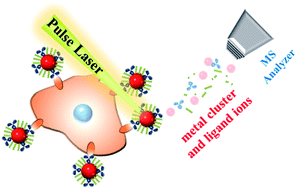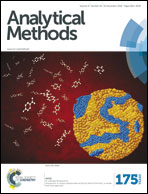Functional gold nanoparticles coupled with laser desorption ionization mass spectrometry for bioanalysis
Abstract
Laser desorption/ionization (LDI) coupled with mass spectrometry (MS) has evolved as an important tool for the analysis of a wide range of analytes, from small molecules to biomacromolecules. The LDI-MS technique requires a suitable matrix or substrate to absorb laser energy for the desorption and ionization of analytes. LDI-MS performed with an organic matrix easily suffers from many matrix effects, such as the formation of many adduct ions, high noise in the low-molecular-weight region, and poor reproducibility. Nanomaterials can reduce the interference of matrix molecules, and improve the reproducibility, sensitivity and even selectivity of LDI-MS. Among the nanomaterial substrates, gold nanoparticles (Au NPs) are an excellent nano-substrate for LDI-MS due to their high photoabsorption, photothermal conversion, and heat-transfer efficiency. Moreover, substantial amount of surface ligand ions and Au cluster ions are formed during the LDI process. By monitoring the ligand ions and Au cluster ions, it is possible to amplify the mass spectral signals and analyze macromolecules with minimum errors. This review highlights some of the applications of functionalized Au NPs coupled with LDI-MS for signal amplification in biosensing and bioimaging applications.



 Please wait while we load your content...
Please wait while we load your content...